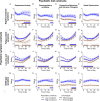The rhythm of mental health: the relationship of chronotype with psychiatric trait dimensions and diurnal variation in psychiatric symptoms
- PMID: 38834543
- PMCID: PMC11150537
- DOI: 10.1038/s41398-024-02943-7
The rhythm of mental health: the relationship of chronotype with psychiatric trait dimensions and diurnal variation in psychiatric symptoms
Abstract
To advance the emergence of circadian-based therapies, this study characterized how psychiatric symptoms fluctuate across the day and vary between individuals. Using a dimensional approach, we determined how chronotype relates to 13 psychiatric traits, and modeled the temporal development of symptoms throughout the day using generalized additive mixed effects models. In this preregistered study, a subclinical sample completed 13 psychiatric trait scales and a chronotype scale at baseline (N = 515, n = 404 women, 109 men, n = 2 non-binary, M age = 32.4 years, range 18-77), followed by 22 psychiatric symptoms and behaviors rated repeatedly between ~08:00-00:00 (n = 410). Key findings are that 11 out of 13 psychiatric traits were associated with being an evening-type, ranging from depression to obsessive comulsive disorder, social anxiety, and delusional ideation, while only mania was associated with being a morning-type. Four distinct psychiatric trait factors were identified, each predicting worse symptom levels throughout the day. Fatigue-related symptoms exhibited strong time-of-day changes with evening-types experiencing worse fatigue in the morning and morning-types in the evening. Evening-types had considerably lower drive and motivation than morning-types from morning to early evening. Evening-types also had more pronounced negative emotional symptoms and ADHD-type symptoms in the evening, particularly among those high in psychiatric trait factors. These findings identified important research targets that hold promise for improving mental health outcomes, such as strategies to boost morning motivation. Furthermore, the results emphasize the relevance of incorporating circadian factors, including chronotype, into translational psychiatric research and interventions.
© 2024. The Author(s).
Conflict of interest statement
The authors declare no competing interests.
Figures



References
MeSH terms
LinkOut - more resources
Full Text Sources

